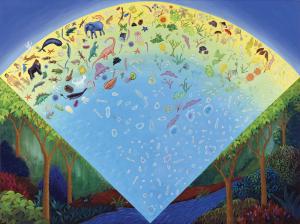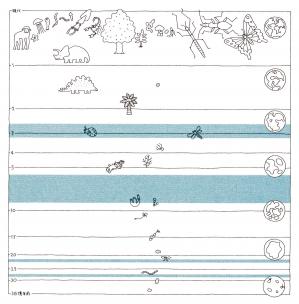Thinking about Biodiversity from a Biohistory Perspective
- Keiko Nakamura
- Director General, JT Biohistory Research Hall
1. What is Biodiversity?
Here I present Figure 1 which explains a perspective of biohistory. This figure is called the “Biohistory Scroll.” You can see diverse living things drawn around the edge of a fan-shape figure: protists such as bacteria and Euglena, fungi, moss, fern, plants including a sunflower, animals including a newt, a dolphin, a kingfisher, and a gorilla. The living things are very diverse – the number of species on the earth is said to be more than tens of millions. Modern biology demonstrates that all diverse living things are composed of cells and DNA is in all cells. Also, the basic function of DNA is common among all living things. Therefore, it is said that all living things share a common ancestor. In other words, all living things were derived from one cell. It is still unknown when and where the first cell was born; however, it is considered that it was born in the sea about 3.8 billion years ago. Since it is known that the conditions to bear new lives are still developing in the deep sea, research on the origin of life will be progressed in the future.
Back to Figure 1. This figure shows that all living things on the earth have a history of 3.8 billion years in their respective bodies. Recently, genomes (all aspects of DNA in cells) are analyzed and we are able to understand that the respective histories of all living things are recorded in cells. Now, we can know about relationships and histories of diverse living things, that is to say “biohistory,” through comparing genomes. We have conducted our research by using small living things such as butterflies, spiders and bees, and realize that the lives of all living things are precious as they might not exist here without the history of 3.8 billion years.
When we think about the world of living things, we tend to think that unicellular organisms such as bacteria belong to a lower layer and humans belong to an upper layer. As shown in the scroll, all living things exist based on the same period of time, and there is no hierarchy among them. The important thing is to understand that humans are drawn in the scroll as living things. This idea is natural according to what we have thought, but it is not common in modern society. Most people are acting based on the thought that humans live outside the scroll, or belong to upper layer, aren’t they?
I already explained that living things are diverse. This is “biodiversity.” Recently, “biodiversity” became an emerging issue as part of environmental problems as interest in the environment has increased. Now, many people are conscious that it is important for living things to be diverse and we should not take actions that may damage living things. But unfortunately, we still think that humans are special and different from other living thing, and conserve biodiversity from outside – don’t we? This idea is expressed in the following words: “be earth-friendly.” But, as shown in the scroll, “humans are part of nature and exist as a type of diverse living thing.” The earth is the existence that holds us and lets us live. We should live so that the earth is friendly to us. The power of the earth is enormous and we suffer from earthquakes, typhoons, explosions, tornadoes and so on. The earth is not malicious – these events only are a manifestation of “the power of the earth.” But they are terrifying and sometimes threatens our lives. I strongly realized the power of the earth when Japan was hit by the Great East Japan Earthquake in 2011. In addition, the damage became greater and more serious due to the accidents at the nuclear power plants. Science and technology representing the modern society brought us new disasters. This experience led me to think about what is important when we live on the moving earth as living things. The “New Biohistory Scroll” is drawn based on such movement of the earth (Figure 2). The blue lines show extinction.
2. What we can learn from the Great East Japan Earthquake
When we think that “biodiversity” encompasses “the existence of humans as one of the diverse living things,” we can realize that we have to review our lifestyles from the latter part of the 20th century to the 21st century. In other words, we have to review our values. In modern civilization, “development” has been an important aspect. The words “developed countries” express this idea. In developed countries, the economy grows, lands are urbanized and we can enjoy convenient lifestyles. That is to say, in developed countries, it is good to live being away from nature as much as possible, and have mechanized and convenient lifestyles.
Concretely, being convenient is “to be able to do fast, do easy and do what we want.” Such things are appreciated. We can think about this by taking rice cookers as an example. Until we used rice cookers, we had to place a rice kettle on the oven, light it and boil rice watching the flame until the rice was cooked. Rice cooking was not easy and took much time. In addition, rice was not cooked as we wanted, and it was sometimes burnt. Now, we can cook rice very easily. All we need to do is to set the timer and press the button. Then, delicious rice is ready at the time we want. It is easy and fast. In addition, we can do what we want. This is wonderful and appreciated.
But, there is one thing that we have to think about. We cannot do it in this way for living things. When we grow flowers, we cannot choose an easier way. A certain period of time is necessary from seeding to blossoming. Moreover, flowers do not always bloom as expected even if we take much care of them. Therefore, living things were considered to be out-of-date and difficult to control. Primary industry is situated based on this background. As a result, in Japan, the food self-sufficiency ratio has decreased. However, are such countries really developed countries? It is high time for us to review this aspect.
It is not necessary to deny building machines in a quest for convenience. However, if we regard building machines as a sole objective, this leads us to deny living things. Let’s think about education. Don’t we request children to do things quickly, be less fastidious, and do what we want? Don’t we regard children who meet such demands as good children? But, such a view is to regard children as machines. Children are living things. Therefore, their living processes are important. Doing things quickly is not always good. Children are really growing when they think about something taking a great deal of time. New things will never be born if children only do what adults want. Creation is to do something unexpected, and therefore living things are interesting. We have to review our value that places more emphasis on the machines’ characteristics and denies the good aspects of living things. This is “diversity.” Diversity is not looked at and conserved from outside, but it is the value of our living time. This is a suggestion from the biohistory perspective.
3. Appreciating humans as living things
There is one thing that we have to reconfirm when we regard “diversity” as our value for our way of living. The diversity of living things is based upon a commonality. It does not allow “anything-goes.”
When based on the idea that humans are living things, it is important to establish a society where we can live in spontaneity and abandon, both mentally and physically. In order to realize such a society, we have to not only produce tasty and safe foods, but also condition medical services, education, housing and the environment. Unlike uniform ideas like machines, respective societies have to establish agriculture, forestry and fisheries by making the best use of appropriate technologies for respective natural environments. Also, it is essential to establish a medical system where young and old can live actively. Based on the idea that children are living things, education should also be a system that appreciates respective personalities and allows diversity. Such a system will lead to building a creative society.
Nowadays, many people sense difficulties in living. In a society where economic growth is measured by the movement of money, or competition is measured by numbers, it is difficult to think long and hard or to require gentleness. If we continuously live in this way, humans as living things will scream, due to the difficulties. Humans should not think from a perspective of being outside living things when thinking about about biodiversity. As living things, humans should realize the importance of biodiversity. By doing this, we will be able to get away from difficulties in living and establish a society where all people can live actively.
Figure 1 Biohistory Scroll
This figure showing the histories of all living things and relationships among diverse living things was designed by Dr. Keiko Nakamura (Director General, JT Biohistory Research Hall), an advocate of biohistory, as a new expression method.
The spine of the fan shows 3.8 billion years ago when the first life was considered to be born on earth. Since then, diverse living things have been born and the living world has become rich toward the edge of the fan, the present. Historical stories of living things such as the appearance of multi-cellular organisms and evolution after a long period of life in the sea, species explosion and so on are shown in the scroll.
(Designed by Keiko Nakamura / Cooperation by Marina Dan / Illustrated by Ritsuko Hashimoto / Provided by JT Biohistory Research Hall)
Figure 2 New Biohistory Scroll
Histories of living things including dynamic movements of the earth such as continental drift and climate change are shown in this figure. The sizes of living things represent the ratios of species. Stories of rich ecosystems created under the influence of interactions between living things and the environment are told.
(Illustrated by Makoto Wada / Provided by JT Biohistory Research Hall)
Profile of Keiko Nakamura
Dr. Keiko Nakamura is Director General, JT Biohistory Research Hall.
Dr. Nakamura was born in 1936 in Tokyo, Japan. She graduated from the Department of Chemistry, School of Science, The University of Tokyo in 1959. She earned her Ph.D. degree at the Department of Chemistry, Graduate School of Science, The University of Tokyo in 1964.
She held positions such as Researcher of National Institute of Infectious Diseases (NIID); Chief of the Social Life Science Laboratory, Mitsubishi Kasei Institute of Life Sciences; Research Director of the Human Nature Science, Mitsubishi Kasei Institute of Life Sciences; and Professor of Faculty of Human Sciences, Waseda University. She served as Vice Director of JT Biohistory Research Hall from 1993 to 2001, and she has served as Director General, JT Biohistory Research Hall since 2002. She also served as Visiting Professor of Research Center for Advanced Science and Technology (RCAST), The University of Tokyo and Professor of Graduate School in Cooperation with Other Institutes, Osaka University.
Dr. Nakamura was awarded the 47th Mainichi Publishers Award for Culture for her book entitled “Jikososhutsu suru Seimei (in Japanese, Life produces itself) (Tetsugaku Shobo) in 1993, and the Excellence Award, the 12th Book Award for Technologies and Sciences by the Nikkan Kogyo Shimbun Ltd. for “Genomu o Yomu” (in Japanese, Reading Genome) (Kinokuniya Shoten) in 1996. In 2000, she both won the 8th Konosuke Matushita Memorial Award of Flower Exposition and the 15th Diamond Ladies Award. She is also an awardee of the Omega Award (2002), the 10th Primula Grand Prix, Osaka Fund for Women (2002), the 45th Osaka Prefectural Prize for Culture (2007) and the Academia Prize (Cultural Sector), The Academic Society of Japan (2012).












